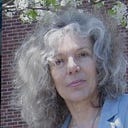Member-only story
Interview with Orna Ross, Acclaimed Irish Poet and Writer

ORNA ROSS is an award-winning poet, writer, and powerful advocate for independent authors and other creative entrepreneurs. She has been named “one of the 100 most influential people in publishing.” Her work includes nonfiction guides for creatives, and she is Founder-Director of two popular online communities, the Alliance of Independent Authors (ALLi) and The Creativist Club. She lives in London with her family and writes, publishes, and teaches in workshops and podcasts around the globe.
Orna’s novels and poems are often haunting in what they evoke and hold a stillness that reminds me of the Japanese poet Basho. After the Rising, the first book of her Irish Trilogy, is a sweeping, multigenerational tale that merges 1920s Ireland with the present. It is a remarkable reading experience. Throughout, I ceased to know I was reading at all — the immersion into the characters’ lives was that strong, evocative, and riveting. Here is just one line from its pages:
The sea-chant of the prayers, breaking in a holy wave across the headstones, down to meet the sound of the sea itself.
I am thrilled she has agreed to an interview.
Greetings, Orna. You have a successful career on three fronts, as a poet, a novelist, and as a leading force in the world of independent publishing. With over 29 books to your credit, what is it you enjoy most about being a writer?
All of it keeps me real, which for me means connected to the invisible, the place beyond place. As Director of ALLi, and as publisher of my own work, my feet are always on the ground. As a writer, my head can traverse the sky and the oceans and I can live many lives, imaginatively. Writing connects me in a different way to the world by connecting me to what seems to lie beyond the world. Trusting the mystery of the creative process allows me to trust the mystery of who we are, why we’re here, where we’re going. Oh, and of course playing with words is the best possible fun. I just love producing them, moving them about, seeing how they fit.
Tell us about the poetry. As a poet, you go deep into the heart and soul. What inspires a poem for you?
